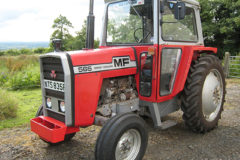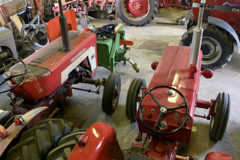Nuffield marque guide
Posted by Chris Graham on 16th January 2020

David Aylward’s concours-grade Nuffield Universal with Perkins P4 engine.
Peter Love takes a down-to-earth look at Nuffield – an often underrated marque, but one that’s recently turned a corner. So now could be the ideal time to invest in one or more Nuffield tractors.
It was during the latter half of WW2 that Morris Motors was encouraged by the Government of the time to consideration manufacturing a tractor. Sir Miles Thomas, vice-chairman of the Nuffield empire, is credited with the conception of a more powerful tractor than the standard bearer of the time – the 28hp Fordson Standard N that had been around since its 1917 inception.
The studies were carried out by Claude Culpin, classed as an agricultural machinery genius, who joined the company on the first day of January 1945. The credit for the original Nuffield tractor, though, lies with Herbert Merritt, who from humble beginnings as an apprentice with Vickers of Erith in 1915-20 ended up with a master’s degree in science and later obtained a doctorate. He joined David Brown in 1932, when the company was a famous gear company – prior to its involvement with building tractors.
Later in the ’30s, Merritt was involved in transmission design for the MoD but went back to David Brown in ’42 and took over tractor design and production until 1945. He took up his new challenge of the Nuffield tractor with glee, as did the team around him.
Due to his close association with David Brown, there was always the wonder that Merritt could have stolen ‘property rights’ and this was discussed at Nuffield board level, at its legal office and also with David Brown. Nothing came of it and, in fact, Merritt moved on in 1949 after seeing the Nuffield project up and running, which for him was the challenge and what it was all about.
It was decided before Merritt arrived that the Morris Commercial EBH 3.5-litre side-valve petrol engine could be developed to a multi-fuel ETA/B/C 38hp unit within Morris Engines Ltd. This unit would form the basis of the original prototype Nuffield Universal tractors that were built and developed, starting with TRX 1 that appeared in May 1946 as a row-crop three-wheeler.
With export markets in mind, particularly Canada, South Africa, Australia and New Zealand, producing a row-crop was a way of persuading the Government to release raw materials for the tractor to be put into production sooner rather than later.
Governing the engine saw the team design its own mechanism with the hand throttle lever on the left, which became a tradition right through to the 10/60. In those early days the hydraulic system was a simple ‘lift and lower’ affair, but lots of work was done in this department when the production tractors came on stream. The two-lever hydraulic system, pulley, PTO and lights were all extra, as was oil and purchase tax.
The production tractors came on stream in early December 1948 at the Smithfield Show as the Nuffield Universal – a four-wheel M4 (cost £487) and a three-wheeled M3 (£495), which proved to have limited appeal.

The M3 is a very desirable tractor and the variant with ‘V’ twin front wheels (MV3) is even more desirable. The diesel-powered ‘V’ (DM3V) is perhaps the ultimate rarity. Expect to pay £6,000-9,000 for a good M3 like this
As for a diesel engine option, that could have been fulfilled via the six-cylinder, 4.5-litre Saurer engine, which Morris had a license to produce. Morris did go on to use the Saurer engine in its late 1940s CV/FC commercial vehicle series, but in limited numbers, but it was problematic.
It looked, from the outside, that a lack of understanding of the diesel engine, which had been a great success for the company that had been making diesels since 1927, was to blame – but, as far as I understand, a prototype was not built utilising this engine. The Nuffield Universal diesel tractor would be offered from 1950, fitted with Frank Perkins’ 48hp P4 engine.
The Universal’s engine was fitted in a very solid frame and a robust five-speed transmission was married to it, driven through an 11-inch, single-plate Borg & Beck clutch and there was a good back end. Drum brakes were fitted to the final drive pinions and the tractor had outstanding torque in the field.
The tractor was well accepted, with production taking place at Ward End, Birmingham (the old Wolseley Motors works), with sales looked after by Cowley.
By 1950, the Nuffield organisation had sold 2,000 tractors – hardly anything to write home about when compared to sales of Fergusons and Fords. This basis of the design took the company through two decades, and although there were changes to the tractor over the years, essentially those original looks and design we all came to know and love so well were around until 1967.
By then, production had been taking place at Bathgate, Scotland, for five years. The orange Nuffield era came to an end in 1969, when production of Leyland tractors began. Unfortunately, the Bathgate period was not a happy marriage and quality control became a major issue. The workers spent more time on industrial action and their needs, rather than the customers’, which blighted Leyland. Tractor production concluded at Bathgate on 15 January 1982 and although that wasn’t the end for the tractors, that’s a story for another day.
Today, these Poppy Orange machines have a loyal following, thanks in part to the work of Pam and Graham Towndrow and the team at The Nuffield and Leyland Tractor Club.

Graham Towndrow’s Nuffield M4 is the second off the production line and is in quite a state. It was updated throughout its life and will be restored to original specification by Nuffield ‘guru’ David Aylward
Graham owns the second Nuffield M4 to come off the production line, which spent its working life in the West Country. Well-known restorer and Nuffield enthusiast David Aylward has just started to rebuild this interesting machine and I look forward to seeing it finished.
David’s first recollection of a tractor on the farm was his father’s M4, which he speaks so highly of. He says that its low-down torque was great and rates the engine better than the Perkins diesel and later DM4 with the 56bhp BMC OEA 34TA/B/D 3.4-litre unit.
On the next few pages I will give you some ideas as to what’s involved when considering buying the more popular models from this marque.
M4: 1948-56

On the early M4s, always check the axle pivot and steering joints for wear
These tractors are still available on the sales field, but finding one that is good is not easy! It took me three years to find an example that satisfied a customer’s requirements. Finding a restored example is even harder, but it is interesting to note that they do not attract a premium price when perhaps they should.
Things to look for include a cracked manifold on the side-valve engine (tucked away underneath the large heat shield), a cracked water pump housing (with parts hard to obtain) and cracks on the right-hand side of the block. Good-quality engine rebuild kits (big end shells, pistons, liners etc.) are hard to acquire and if you can find an original kit, always snap it up!
The axle pivot pin and bush are prone to wear and the steering pivot arm also wears badly, particularly on the early design arrangement.
The five-speed transmission is normally very good and is beefy enough to take the stress loads, but bearings are available if needed. The 11-inch clutch is similar, in that it is usually okay, but parts are available if needed.
Make sure the tractor is fitted with the correct early wheels and remember that the hydraulic system and pulley were options, not standard. The Lucas components in the electrical system are reasonably easy to obtain and the magneto can be repaired too.
DM4: 1950-54
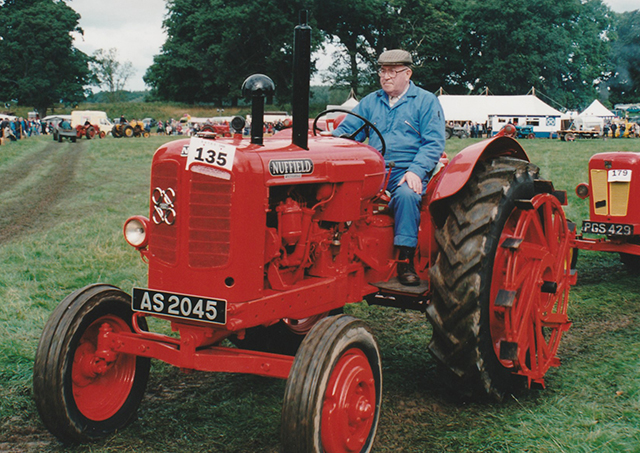
A Perkins P4-powered DM4, complete with wheel strakes
A similar tractor to the earlier M4, but Nuffield’s first diesel tractor with the Perkins P4TA, rated at 45bhp. These tractors are not so hard to find, but are not an everyday occurrence. Finding a good one is not easy, as the ones offered are normally very worn out.
On running examples, check for an oil leak on the front timing case, indicating a worn crankshaft – which is very common. As on the P6 engine, check the nearside of the cylinder block, 2mm from the top, for cracks.
The water pump is a problem on these tractors too and parts are hard to find. The CAV starter motor can cost at least £500 to rebuild too, so be mindful of this.
From 1951, a handbrake lever and tachometer were fitted and an optional hand clutch and overload release was offered.
The transmission is similar to the M4 and is like driving a Farmall from the same period – in other words there’s a big gap between fourth and fifth, but the DM4 is reasonably speedy in top. The steering, although it was modified from the M4, experiences similar problems to its predecessor.
When restored, the DM4 makes a lovely tractor, but finding panels can prove troublesome.
DM4: 1954-57

An original-style Nuffield Universal with BMC diesel engine
From 1954, the DM4 featured the 56bhp BMC OEA 34TA 3.4-litre engine with five-bearing crank and a more powerful hydraulic pump with lift capacity of 2,830lb. In 1956, the deluxe version had the option of a double 11in clutch.
Back to the engine and the main issue is wet liner failure, leading to oil/water contamination. This problem blighted these engines, but it can be relatively easy to replace the liners and O-rings, which are readily available. The problem is overcome these days with additives in the cooling system.
The steering was modified by this period, but the drag and track rod still need close inspection on your prospective purchase.
Universal Three: 1957-61
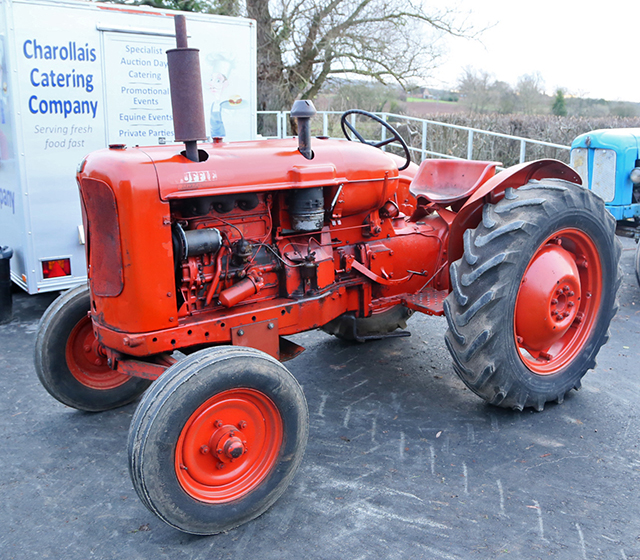
The Universal Three sported a 2.55-litre, three-cylinder engine rated at 37bhp
The smaller Universal Three was similar to the DM4 in many respects, but the big difference was the 37bhp, three-cylinder BMC OEC 25TA/B/D engine (later examples produced 40bhp). The engine also suffered from line problems and does not always run smoothly – which can be put down to the governors requiring attention.
The CAV inline injection equipment is straightforward, but the copper injector sleeves in the cylinder head are notorious for leaking and can be a problem to sort out. Thankfully, modern sealants usually put things right in this area.
The tractor had independent brakes as standard, but a differential lock was optional. With its smaller wheels and narrower mudguards, the Universal Three makes a great pairing for the DM4.
3/42: 1961-64

A shiny Nuffield 3/42 that’s had a new lift pump fitted – a common item to replace
With production now at Bathgate, Scotland, the 3/42 was fitted with the 40bhp BMC OEG 28T engine, still coupled to the five-speed transmission and with pedal-operated differential lock as standard. The steering system was further modified, but the engine liner problem remained.
This is quite a popular tractor on the scene and some excellent examples are about. A number of good tractors have been offered in the last year, including some original examples.
They can be inexpensive to buy – with a nice example selling for only £1,400 in December 2019, complete with good tyres.
10/60: 1964-67

A Nuffield 10/60 in this condition, with a Lambourn cab, is much in demand
Now offered with a 10-speed transmission, the 10/60 didn’t really have any additional speed, but there was more variety in terms of field speeds thanks to the dual-range gearbox. The tractor was fitted with the 57.5bhp BMC 38T/TA 3.77-litre engine, which suffered more of the same problems as the other BMC four-cylinder engines, although a mechanical governor was fitted to the injection pump.
Build-quality problems became a factor and the model had a habit of ‘eating’ Lucas CAV starter motors. These days, the starter motor is relatively cheap to repair if the need should arise.
The hydraulics featured draft control as standard (as on the previous 4/60) and a single-acting top link. Independent Girling dry disc brakes were added, but they were not without their problems. They did not pull up straight and were known to seized up. Parts are available to overhaul them, we are told.
Power-assisted steering was an option and independent PTO was standard on deluxe models.
The 10/60 is readily available and comes up in all conditions, but mostly well used. Many are fitted with a Lambourn open frame. Like the 10/42, the 10/60 features the later-style Sankey pressed wheels.
4/25: 1968-69

A Nuffield 4/25 in original condition, with wheel weights, can command more than £5,000 at a sale
The 4/25 was introduced in 1965 as the lightweight BMC Mini and received a hard time from the farming press. This was rather strange, given that the design had originated from Harry Ferguson Research Ltd. and was seen as a ‘replacement’ for the Ferguson TE-20 range. It was offered in 20bhp petrol and 15bhp diesel form, using the BMC A Series engine.
The monocoque construction was different to other Nuffields and the three-range, nine-speed transmission was also rather unusual for those used to the larger tractors, but the hydraulic system was good. The early ones weren’t reliable, lacked power, smoked and can be very hard to start.
In 1968, the Nuffield 4/25, with the more powerful BMC B Series engine, arrived. The petrol version produced 28bhp and the 1.5-litre diesel was rated at 25bhp.They were now well styled at the front end and were a far better proposition, but still not the best of starters. It is said that you can get over the starting problem with a different heater plug arrangement. Watch for glazed bores and blue smoke.
A good number of them, including many original examples, are around and parts can be found. Do keep your eyes open, as they are easy to get about and great fun to own.
3/45: 1967-69

An interesting 1968 Nuffield 3/45 with yellow engine and wheels. Don’t dismiss a tractor like this, as closer inspection reveals an excellent bonnet and nose
The 3/45 was a very different-looking tractor as BMC tried to catch up with the opposition. Sales were on the wane for Nuffield and so the tractors were changed to have more appeal. The effort was to make things easier for the driver and to bring everything up-to-date. Included was a 15-gallon fuel tank, a wider footplate, Plessey hydraulic pump with more punch (3,350lb lift capacity) and a BMC 2.8-litre three-cylinder engine, rated at 45bhp, provided the power.
This model has a slightly revamped 10-speed transmission, the steering was redesigned and a double-acting top link changed things in the draft control department.
It’s certainly a great looker, but finding some of the cosmetic elements can prove tricky. They can be quite expensive tractor to restore, but look lovely when finished. They are quite nice to drive too, but not fast.
Finding a good, original one is not that easy, but they still come up – with more 3/45s about than 4/65s.
4/65: 1967-69
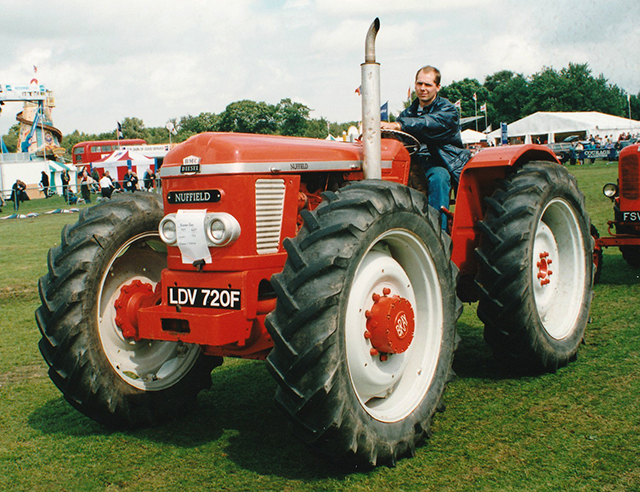
A Bray conversion of the 4/65, dating from 1967. A tractor like this is worth approximately £23,000-28,000
The ultimate Nuffield in this livery has to be the 4/65 – with the BMC 3.8-litre 38T/TA engine and 65bhp to play with. Both still have the engine liner problems and the radiators had a habit of blocking up, causing overheating. The 4/65 commands top Nuffield prices, particularly for good examples, for this relatively short-run tractor.
They are quite heavy to drive and not very fast, but can be a delightful tractor to own, They can take a bit of time to set up properly, but are worth it when completed. One or two original examples come up from time to time and can fetch more than £5,000.
Conclusion
Nuffield tractors are certainly underrated, but finding panels is a major problem if you are restoring one. If you are looking for general parts, or even complete tractors, there are several specialists in the UK – but perhaps the two best known are J Charnley & Sons of Brindle, Lancashire (tel: 01254 854103 or www.charnleys.com) and Tractor Spare Parts Ltd. of Alstonefield, Derbyshire (tel: 01335 310538 or www.tractorspareparts.co.uk).
A good number of tractors come up at sales regularly, so it might be worth collecting some donor examples to help you along the way. Luckily, there are still people around who built them, worked them on the farm and enjoyed them and that’s what it’s all about.
No rally would be the same without a Nuffield or two! Prices are on the up again, so it’s time to invest!
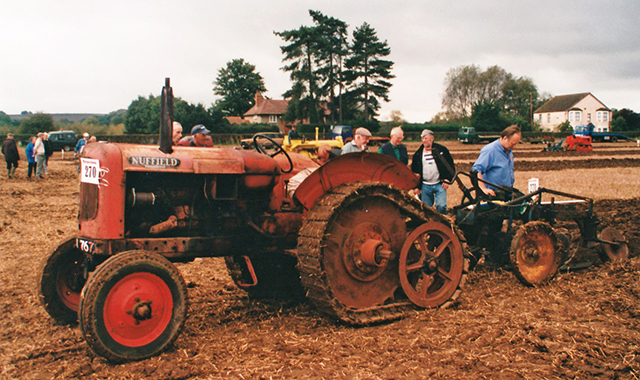
A Roadless-tracked Nuffield Universal DM4 is difficult to value. If one ever came up it would probably fetch between £9,000-13,000
To subscribe to Tractor & Machinery magazine, click here



